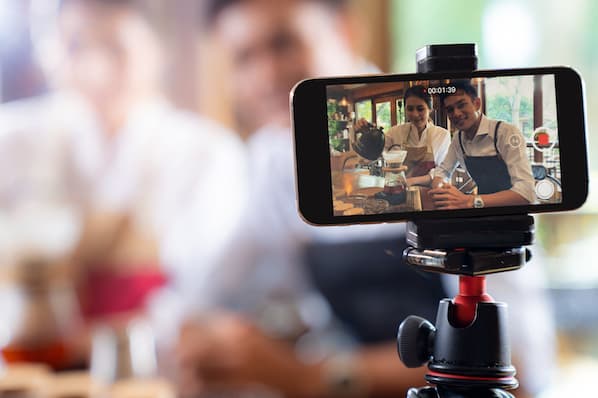During the last few years, Facebook has emerged as a real contender for the online video platform throne. In wake of several new video features being introduced and a heavy video focus from Mark Zuckerberg, the social media giant has over 500 million people watching Facebook videos every day.
Facebook's increased focus on video isn't only because users like to watch it (although they clearly do) -- it's also because more marketers are shifting their budgets from TV to mobile video. The allure for advertisers lies in Facebook's hyper-surgical targeting possibilities and the results Facebook videos can deliver.
If you're one of those marketers who wants to dive into advertising with Facebook videos -- but isn't sure where to start -- keep on reading.
Below we'll review the types of Facebook video ads and how to create an effective ad with tips from HubSpot advertisers. Then, we'll look at some examples to put it all into practice.
Download Now: Free Facebook Advertising Checklist
Types of Facebook Ads
- Slideshow
- Stories
- In-stream
1. Slideshow
You might think that recording and creating a video for a Facebook ad is a daunting task. However, with slideshow ads, all you need to do is create a video using only photos and text.
Whether you use your own photos or stock images, slideshow ads are easier to put together and don't take too much time.
This is a great way to engage audiences without spending time and money on creating a video.
2. Stories
If you've created a video for your Facebook feed, you can repurpose the same content as an ad that will play in Facebook stories.
Story ads are a great way to reach your audience where they're at.
3. In-stream
In-stream ads are the closest way to replicate traditional TV advertising on social media.
For this type of ad, you'll create a video that will play when people are watching Facebook videos. If you've ever watched native content that was interrupted by an ad, that was an in-stream ad.
Now that you know the type of ads, let's discuss how you'll create and launch an effective Facebook video.
How to Create and Launch an Effective Facebook Video Ad
- Set your objectives.
- Choose your target audience.
- Plan the video creative.
- Create the video.
- Set up your Facebook campaign.
- Track your campaign.
- Evaluate your campaign.
- Iterate.
1. Set your objectives.
The first step of any marketing effort is to decide what you want to accomplish. In your Facebook video ad campaign, are you trying to increase brand awareness or drive conversions? Choosing what you're going to prioritize should affect what kind of video you should create and how you should distribute it.
So choose your KPIs and plan accordingly. Below I've organized some common KPIs around three categories: engagement, audience reach, and brand lift.
Conversion KPIs
- Clicks
- CTR
- Revenue Generated
Engagement KPIs
- Engagement (Share, likes, comments)
- Audience Retention (How much of your video the viewer watch)
- Relevance Score (How relevant your video is to your audience)
Audience Reach KPIs
- Impressions (How many people viewed your video)
- Percent of In-Target Audience (What percent of your target audience you reached)
- Brand awareness
By choosing which metrics you want to track and what goals you're trying to reach before you actually start creating your video, you're more likely to be successful.
2. Choose your target audience.
Who are you targeting with your video ad campaign? Yankee fans between 30-40? Newlyweds who shop at Costco? Millennials who play Minecraft? Or the people who already like your Facebook page?
The true power of video advertising on Facebook is the targeting capabilities. Forget spray and pray -- you need a hyper-targeted group of people for your ad's audience. Narrowing your target group will give you less overall views, but because you're reaching only the people who are relevant, your CTR is likely to be higher.
Leticia De Bortoli, a principal video editor at HubSpot, says, "Think like a user. People don't go on Facebook to watch ads, and most people actually want to avoid ads at all cost. With that in mind you have to invest in your ad. Take the time to create something very compelling that can act as a thumbstopper, otherwise people will scroll right by your ad."
She adds, "Take the time to learn about your target audience. You might find specific interests and behaviors that can inform your creative and help you develop more compelling ads."
Which targeting options you should have is dependent on what target audience you have, but here are some key targeting options for an effective Facebook video ad campaign:
- Gender
- Age
- Location
- Interests
- Behavior
- Relationship status
- Work (Job title, Office type)
- Financial income
- Home (Type, Value, Ownership)
- Market segment (Ethnicity, Generation, Household composition)
- Parents (Age of children)
- Life events
- Device owner
If you go to the "Audience Insights" page in the Facebook Ads Manager, you can play around with the different options to define your target audience. Hopefully you have a pretty good idea about who your target market is based on your buyer persona research, but finding the best audience for your video ads might require a few attempts.
This is a prime opportunity to really confirm your optimal target audience. What target audience has the highest CTR? What target audience has the highest LTV? Use the data you get from your campaigns to evaluate both your Facebook campaigns and your larger marketing strategy.
3. Plan the video creative.
With your KPIs and target audience decided, you know what you want to accomplish and the people you want to reach. Now it's time to plan your video creation. A good, solid plan for your video will increase the chances of it coming out looking good. Here are the things you should decide before you even touch a camera.
- What is your topic? For example, if you're in the boat paint business, you might choose a topic like "How to buy the right environmentally friendly boat paint."
- What will your key takeaway be? What message do you want to convey to your audience? For example, "Our metal-free bottom paint lasts longer than normal paints and is more environmentally friendly."
- What is your CTA? For example, "Use this code to buy our metal-free bottom paint for 20% before August 1st!"
De Bortoli says to keep in mind that less is more.
"In social media advertising, one second is a lot of time. Have one clear message and one clear story that will center all the other elements of your ad," she says. "Focus on delivering that central message in a very interesting way, instead of having multiple messages fighting to coexist in a few seconds."
Megan McCall, a motion designer at HubSpot, agrees.
"Make the first 5 seconds the most compelling part of the ad. It's tempting to leave the pay-off of the ad until the end, but it's likely a user will catch your ad while scrolling, so you want to appeal to them early and make it clear what your company is about," McCall adds. "That's why we often try to put the UI early, along with a mention of our brand and a clear value prop."
Keeping all this in mind, it's time to write the script. Write up what you want to say, how you're going to say it (if you're doing a voice-over), and what graphics and text you need. Make sure that your message is on point and not too long. It should sound natural when read aloud. And try to keep what you say to a minimum -- when it comes to online video ads, "less is more" is a better approach.
4. Create the video.
This is where things can get a little bit complicated. What kind of gear you need all depends on your experience level and how often you're planning to do videos in the future.
For most beginners, a good smartphone and a microphone could be enough to get some decent photos or videos. But if you are devoting more resources to video, you might consider trading up to some higher quality gear and thinking about lighting and studio set up.
McCall says, "When you create a video, include your logo or a mention of your brand in the first 5 seconds. Monday.com does a great job at this here."
Additionally, she says to consider adding burned in captions for viewers who don't use sound.
Rex Gelb, the director of acquisition analytics and paid advertising at HubSpot, says, "The best video ads on Facebook tend to grab people's attention in the first couple of seconds. People are busy and scrolling through their feeds fast -- you have about 2 seconds and 2 inches of real estate to engage them before they fly by. Make it count!"
If you are looking to easily create videos from the product photos you've already got, check out this guide. And if you're looking to up your video game, check out Wistia's DIY office studio guide.
5. Set up your Facebook campaign.
Once you've created your video, it's time to set up your Facebook video ad campaign. Setting up a video ad on Facebook is relatively straight-forward process, especially if you're used to setting up normal Facebook ads. Facebook does a good job of walking you through the process of setting up the campaign through either the Ad Manager or the Power Editor. Here are the basic steps you need to go through:
- Start creating an ad and choose "Video Views" as your objective. You could choose to "Boost Post" as well, but choosing "Video Views" will give you a lower cost per view.
- Choose your audience. Like I mentioned before, you have a wealth of targeting options at your disposal. You can also retarget previous website visitors or use any of the Custom Audiences you might already have, like your email list or app users. You can also target the fans of your Facebook page.
- Set budget and pricing. Choose how much you want to spend, over what time, and what you want to optimize your ad for.
- Upload your video. Be sure to choose your video thumbnail carefully -- it could affect your views.
- Edit your ad copy. Add the text copy and your CTA. Choose where you want your ad to be served, on web or mobile or both.
6. Track your campaign.
Here are a few ways to track the different metrics I mentioned earlier in the post.
Conversion KPIs
Use a URL with UTM codes to track the traffic from the ad to your website. Your marketing software should make it easy for you to track incoming traffic and subsequent conversions, and compare your video campaign to other campaigns you've run.
You can also use Facebook Conversion Pixels to see the long-tail effect of your video campaign. For example, if someone visits your site after watching an ad, leaves, and then comes back, that information would be shown in the conversions column of your Facebook ad analytics.
Engagement KPIs
Tracking your engagement KPIs is a relatively straightforward process. Just go into the Ads Manager, choose "Campaigns," and click on your ad to see how it performed.
Audience Reach KPIs
Similar to engagement, audience reach is simple to track on Facebook. On the "Campaign Report" page, see how many people viewed your ad and what your Relevance Score is. The Relevance Score will help you evaluate if your target audience actually liked your video. If your Relevance Score is poor compared to scores for other ads shown to your audience, Facebook will limit the reach of your video. The better the video and the better the targeting, the better your Relevance Score will be.
7. Evaluate your campaign.
After your video campaign is over, it is time to take a step back and evaluate how successful your campaign was. Go back and check your KPIs and see if you hit your goals.
Conversion KPIs
How many conversions did you get from your video campaign? Did people who clicked through to your website bounce quickly, or did they convert on your content? Did retargeted visitors convert at a later stage?
Engagement KPIs
Did people who saw your video engage with it? How many shares, likes, and comments did you get? How many of those were from organic sharing?
Audience Reach KPIs
Did you plan on reaching 10,000 people with your video/budget, but only reached 7,000 people because your Relevance Score was too low? You might want to think about how good your video is and how well it is aligned with your audience's wants. A good idea is to keep track of your videos' performance in a spreadsheet -- Social Media Examiner has a great template you can use. That way, you can compare and evaluate your different campaigns, and figure out what kind of videos actually resonates with your audience.
8. Iterate.
After you've evaluated your video campaign's performance, it is time to do it again! Think about what went well and what you could improve. Is the video content you're putting out good enough? Is your targeting on point? When you have enough data from previous campaigns, you can easily compare them to see what works and what doesn't -- and then make changes on future ads.
To really dive in deep, you might consider taking some lessons or classes on Facebook video ads, like the one HubSpot has.
Examples of Compelling Facebook Video Ads
1. Monday.com
This is a great Facebook ad because it mentions the brand/logo in the first few seconds. As a user, you immediately know what you're getting.
Additionally, the script is easy-to-understand. There are plenty of quick cuts, which makes it more interesting to watch.
2. Colgate
This is one of the best ads I've seen on Facebook. Colgate chose a very compelling topic, "What would you do with your Tooth Fairy money?" In the first few seconds, you're introduced to an engaging question and you can see that kids are going to be the ones answering the question.
Besides puppies, showcasing wholesome content is a great way to get people to stop and watch your video.
3. Squarespace
This Squarespace ad is compelling because the company showcased a celebrity partner. When you're fighting in the first 2 seconds to get people to stop scrolling, showcasing their favorite celebrities is a great tactic.
Ultimately, creating Facebook ads is an important marketing tactic to consider. You can reach a lot of people in your audience, because most people watch videos on the social media site every day.
Editor's note: This post was originally published in July 2015 and has been updated for comprehensiveness.
.png?width=112&height=112&name=Image%20Hackathon%20%E2%80%93%20Vertical%20(75).png)


![Anatomy of a Facebook Ad: How to Create Scroll-Stopping Campaigns [+ Examples]](https://www.hubspot.com/hubfs/anatomy-of-a-fb-ad.png)







